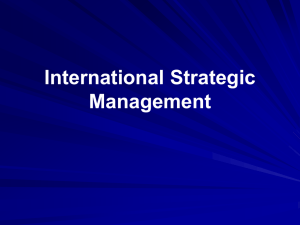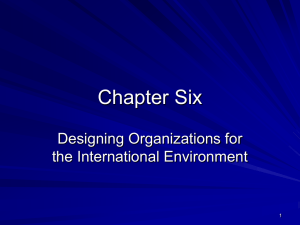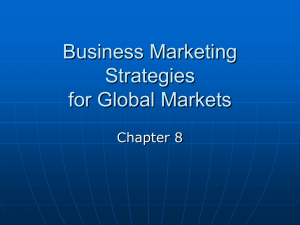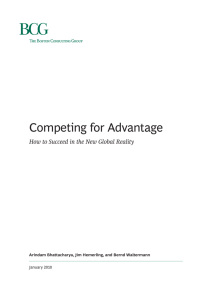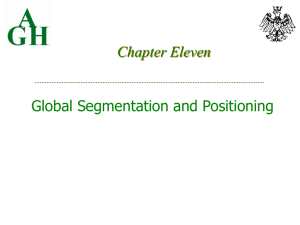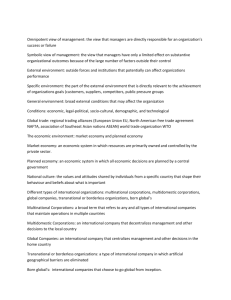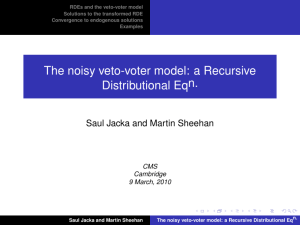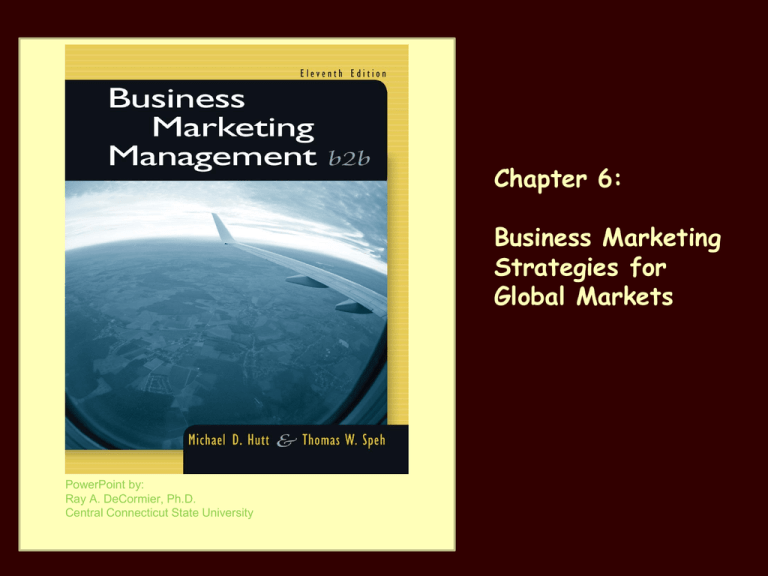
Chapter 6:
Business Marketing
Strategies for
Global Markets
PowerPoint by:
Ray A. DeCormier, Ph.D.
Central Connecticut State University
Chapter Topics
How to capture sources of global advantages
in rapidly developing economies (RDE) such
as China and India
Spectrum of Market entry options
Strategic significance of different forms of
global market participation
Distinctive types of international strategies
Essential components of global strategy
Global Competition Is Here
Huge international firms, which are
relatively unknown here, are challenging
US companies in almost every global
setting.
B2B marketing is world wide and the very
existence of many companies will be
decided by its ability to:
1.
Act decisively
2.
Compete aggressively
3.
Seize market opportunities
This Chapter Shines Light On:
1.
2.
3.
4.
Rapidly Developing Economies (RDEs)
and their source of global advantage
International entry options
Comparison of multidomestic & global
strategies
Critical requirements for a successful
global strategy
4
RDEs are emerging as serious competitors in world
markets. Their advantages are labor costs and, in
some cases, abundant raw materials.
80% of the world’s population is located in RDEs
[i.e., China, India, Mexico, South America (Brazil),
Eastern Europe and Russia].
Hundreds of millions of people are now considered
middle class and form a significant market.
There are 25 world-class emerging multinationals.
By 2025, there will be at least a 100.
Global Advantage
In order to compete in a world economy,
companies need to become global.
The strategy is to meet the needs of both
low growth and high growth markets.
We need new competitive models to
handle the current shifts from west to east
and the rise of the challenge of RDEs
New philosophy of “manyness” vs. the old
approach of “oneness.”
Figure 6.1 The BCG Global Advantage Diamond
Growth advantage
Market
access
Integration
advantage
Network
coordination
Local
adaptation
“Manyness”
advantage
Resource
access
Resource leverage
advantage
Source: BCG
analysis.
Developed by Cool Pictures and MultiMedia Presentations
7
Copyright © 2007 by South-Western, a division of Thomson Learning, Inc. All rights reserved.
Integrated Strategies Include:
• Market access: driving sales growth by reaching new
markets and targeting new
market segments;
• Resource access: leveraging valuable resources (for
example, talent, assets, raw
materials, and knowledge) in RDEs to achieve competitive
advantage;
• Local adaptation: developing and adapting products and
services to satisfy the
unique needs of RDE customers;
• Network coordination: integrating operations to capitalize
on the strength of the
company’s global network.
What Products Should Go? What Should Stay?
The decision to relocate manufacturing, R&D, and
other services is a strategic decision involving:
1.
2.
3.
Economic issues abroad and at home
Competitive concerns
Environmental issues
What Products Should Go to RDEs?
Activities that could be outsourced
include:
Products with:
1)
2)
3)
4)
High labor content/costs
High growth potential by keeping the price low
Large market potential in the RDEs
Standardized manufacturing processes
What Services Should Go to RDEs?
Services that:
1. Are rule-based
2. Have high labor costs
3. Have well-defined processes
Example: Call centers, accounting,
programming
What Should Stay?
Products, services or jobs that:
1. Protect intellectual property (IP)
2. Demand extreme logistical requirements
3. Possess high technology content
4. Possess high performance attributes
5. Customers consider sensitive to their
business
Example: Military products or processes
Table 6.1 summarizes this issue.
Table 6.1 – Determining Which Products to
Outsource and Which to Keep In-House:
Selected Criteria
Maintain Home-Based
Manufacturing
Relocate to RDEs
Labor Contract
Low
High
Growth of Demand in Home Market
Low
High
Size of RDE Market
Low
High
Degree of Standardization
Low
High
Intellectual Property Content
High
Low
Logistical Requirements
High
Low
Source: Adapted from Arindam Bhattacharya et al., “Capturing Global Advantage: How Leading Industrial Companies Are
Transforming Their Industries by Sourcing and Selling in China, India, and Other Low-Cost Countries,” The Boston Consulting
Group, Inc., April 2004, accessed at http://www.bcg.com, pp. 26-30.
Local Adaptation
Shift power to where the growth is.
Build new offerings from the ground up.
Build LGTs from the ground up, just like forming a
new company.
Customize objectives, targets, and metrics for the
RDE environment.
Provide senior executive support to the LGT,
including a direct reporting link to senior
management
Network Coordination
Share best practices
Standardize processes
Resource advantages developed in different
markets can be shared and diffused to other
operating units around the world
Take innovations developed in RDEs back
to developed markets
Spectrum of Involvement in
International Marketing
• First step for developing an effective international
marketing strategy is to understand alternative ways
that firms can participate in international markets.
• Next, entry mode selected should consider firm’s level
of experience overseas and its evolutionary stage in its
international involvement.
Entering the Global Marketplace
Sell domestically-produced products to
buyers in other countries
Management
Contracting
Includes management and manufacture
contracting from making to assembling
Strategic Alliance
A business relationship between two or more
firms to cooperate through mutual need
Joint Venture
Domestic firm buys/joins a foreign company
to create new entity
Multidomestic
Companies work together to find a balance
between local adaptation & global optimization
Global Strategy
A business relationship established to cooperate
out of mutual need and to share risk
Risk Levels
Risk
Global
Strategy
Multidomestic
Strategic
Alliances
Joint
Ventures
Contracting
Export
Return
Entry Modes: Exporting
a.
b.
c.
d.
Least commitment
Lowest risk
Workable when firm lacks resources to make a
significant commitment to the market
Reasons for non-committal include:
a.
b.
c.
Political
Economic
Unfamiliar with market’s requirements or culture
Management Contracts
When equity participation is not feasible, many
partners turn to management contracts to
participate in the venture.
A management contract is an agreement for one
company to perform a specific function under a
contract basis. Specific functions may include:
Organizational skills
Specific expertise
Management services
Turnkey operations: Arrangement permits client to
own, operate and control an operating system for a
% of gross sales.
Contract Manufacturing
Involves the sourcing of products from,
say, China. The purchaser (marketer) may
market the product under their own brand,
post their own label and market/distribute
it there and/or in other countries.
Key requirement is quality management.
Contract manufacturing is most
appropriate when:
Local market is too small to justify
investment
Export entry is blocked
Quality licensee is unavailable
Strategic Alliances
Strategic alliance – A relationship between
partners involving commitment of capital,
management and technical resources.
The objective is to enhance both parties
competitive positions, such as cutting or
sharing costs, and/or get into new
markets.
Example: GM & Toyota
•
Partners have different organizational structures.
This can create problems for marketing and product
design decision-making. This may lead to problems
in coordination and trust.
•
Partners that combine their best skill sets in one
country may be poorly equipped to support partners
in other countries. This can lead to global
implementation problems.
•
Quick technological change often guarantees that
most attractive partner today may not be most
attractive partner tomorrow.
Joint Ventures
Involves the joint ownership of a company to
produce/market into a host country.
Joint ownership is the development of a new
company where both parties have a stake (equal
or majority).
Contributions do vary widely from R&D, know
how, financial, sales, or to whatever.
Joint Venture Advantages
1. Spreads the risk
2. Opens up new markets to both
3.
4.
5.
6.
organizations
Provides a better relationship to each
other’s local community
Less vulnerable to political risks
Alien companies are quickly and easily
oriented to each other’s culture
Any other advantages?
Joint Venture Disadvantages
Many joint ventures are disbanded because they fall
short of expectations.
Unable to mutually disclose intellectual property
Unable to agree on how profits should be divided
Differing management styles
Different perception of the strategies
The relationship could even morph into
competitors
Global Strategy
A global strategy seeks to achieve a competitive
advantage by integrating its operations across
countries.
It might start with a standard core product and
adapt it as necessary to targeted countries on the
basis of contribution to globalized benefits.
Examples: Automobiles, commercial aircraft,
consumer electronics, machinery, etc.
Upstream Activities
Upstream activities include primary
activities that do not necessarily need to
be tied closely to the buying market such
as manufacturing.
Where is manufacturing really needed?
Where are services really needed?
Where is marketing really needed?
Downstream Activities
Downstream activities involve primary
activities where the need is as close to the
buying market as required.
Example: Many products need to be sold
through salespeople who need to be in the
market.
Where is manufacturing really needed?
Where are services really needed?
Where is marketing really needed?
MULTIDOMESTIC VS. GLOBAL
Multidomestic competition occurs when:
Downstream activities are important to
competitive advantage so firms can pursue
separate strategies in each country.
Competition in each country is independent
of competition in other countries.
Global competition occurs when:
Upstream and support activities are vital to
competition where a competitive position in
one country effects the competitive position
in another country.
According to Pankaj Ghemawat, companies need to
be careful in which strategy (global vs.
multidomestic) they employ because
internationalism is only at 10%.
Differences in many cultures do matter.
Many countries are protectionists and will only trade
in one direction.
Many countries don’t value intellectual property
rights.
Some countries are reasserting national sovereignty.
Thus, the decision to follow a purely GLOBAL
strategy must be carefully scrutinized.
Two Dimensions of Competition:
Coordination & Configuration
Configuration is concerned about where
each activity is performed. They range
from centralized to decentralized.
Centralized can produce economies of
scale and a reduced learning curve.
However, centralized may not be close
enough to the market and the cost of
getting products there may be greater
than the savings.
Two Dimensions of Competition:
Coordination & Configuration
Coordination refers to activities that
are performed in different locations
worldwide but are coupled with each
other.
Example: A plant in one country makes
bumpers, a plant in another country
makes doors, and a third plant near
the market assembles the car.
Integration of Coordination &
Configuration
Integrating coordination and configuration to the
value of activities results in various international
strategies:
I.
II.
III.
IV.
High Foreign Investment – extensive
coordination
Country-centered strategy – low coordination
Purest Global Strategy – high value-based
activities
Export based – decentralize marketing; low
value-based activities
Types of International Strategies
Which International Strategy?
The nature of international competition is the determinant
as to which strategy to employ.
Employ a global strategy when a position in one country
affects a position in another country.
Employ a multidomestic strategy when a position in one
market does not affect a position in other markets
(markets are independent of each other).
It is important to view each market in terms of:
Culture
Administration/Political climate
Geography
Economy
Framework for Global Strategy
Build on foundation of
unique competitive position
Emphasize consistent positioning strategy
across international markets
Global
Strategy
Establish clear home base
for each distinct business
Leverage product-line home bases
at different locations
Source: Adapted from
Michael E. Porter,
“Competing Across
Locations: Enhancing
Competitive Advantage
through a Global Strategy,”
in Michael E. Porter (ed.),
On Competition (Boston:
Harvard Business School
Press, 1998), pp. 309-350.
Developed by Cool Pictures and MultiMedia Presentations
Disperse activities to
extend home base advantages
Coordinate and integrate
dispersed activities
Copyright © 2007 by South-Western, a division of Thomson Learning, Inc. All rights reserved.
Global Strategy: Build upon a
Unique Competitive Position
1.
Globalize in those businesses and
product lines where the firm has a
unique competitive advantage.
2.
Advantage must be on cost and/or
differentiation where value
supports a premium price.
Global Strategy: Emphasize a
Consistent Positioning Strategy
1.
2.
3.
4.
Maintain a consistent product and
service offering from one country to
another.
Strategy requires patience and
long-term dedication.
It is not necessary to try and
expand product assortment to
capture a limited market.
It’s better to maintain a consistent
position.
Global Strategy: Establish a Clear
Home Base for Each Business
1.
2.
Corporate location is not as
important as having a clear home
base.
Home base is where:
1.
2.
3.
4.
Strategy is set
Core product & process technology is
created
Critical mass of production resides
Research & service is conducted
Home Base (continued)
Home base should be located
where there is favorable access to:
1.
2.
Required resources
Supporting industries
Home base should serve as the
integrating point for activities.
Home base should have clear
worldwide responsibility for the
business unit.
Global Strategy: Leverage
Product-Line Home Bases at Different
Locations
As a firm’s product line broadens
and diversifies, different countries
may act as a home base for some
of them.
These home bases should offer
best locational advantages:
To suppliers
For serving customers worldwide.
Extending Competitive Advantages
Having a strong home base to house
core activities is important.
However, other activities can be
dispersed to extend the firm’s
competitive advantage.
Three areas are…
Disperse Activities to Extend Homebase Advantage
1. Capture competitive advantages in
procurement by purchasing at most costeffective locations.
2. Securing or improving market access by
locating selected activities at their proper
location to take advantage of costs,
politics, and/or local preferences.
3. Selectively tapping competitive advantages
at other locations for skills, materials or
technologies.
Global Competitors Achieve
Unified Action By:
• Establishing a clear global strategy
• Developing consistent information and
accounting systems on a worldwide basis
• Encouraging personal relationships that
facilitate transfer learning among managers
• Carefully designing incentive systems to
ensure that rewards accrue for truly valuedriven actions

